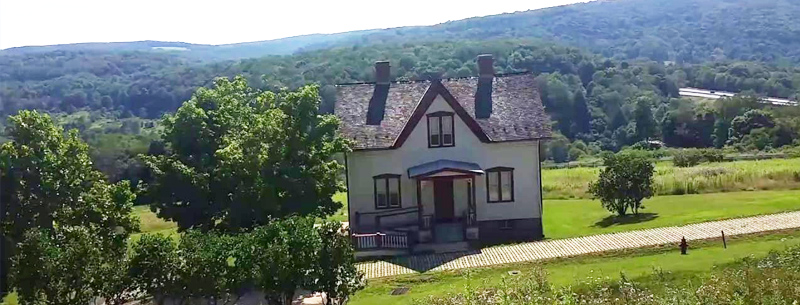Located in Southwestern Pennsylvania, Johnstown Flood National Memorial, established in 1964, commemorates the Great Johnstown Flood of May 31, 1889, and preserves the remains of the South Fork Dam.
After a night of unprecedented rainfall, one of the world’s largest earthen dams collapsed, sending a wall of water over sixty feet high into the Little Conemaugh River valley. For nearly ten years, the South Fork Dam held back the majestic waters of Conemaugh Lake.
By most accounts, the dam failed at 3:10 in the afternoon. An hour later, the Flood reached Johnstown, 14 miles downstream. Along the way, the Flood destroyed almost everything in its path, causing more than $17 million in property damage.
For months, the Conemaugh Valley counted its dead. The death toll of the Flood would be set at 2,209, although it forever remained uncertain just how many were killed on that Black Friday.
Today, visitors to Johnstown Flood National Memorial can stand inches away from where the dam failed and reflect on the awful events of that day. Visitors can gain an appreciation of the historic scene of both before and after the breaking of the South Fork Dam. In the distance, visitors can also see the surviving buildings of the South Fork Fishing and Hunting Club…reminders of a life once lived in the Allegheny Mountains.
South Fork Dam Trivia
- The Johnstown Flood is considered the first major peacetime calamity in American History, although debate continues on whether the flood was a “natural” disaster.
- The Great Storm of 1889 was the worst in recorded history to that time. Over eight inches of rain fell near Johnstown. The storm caused Conemaugh Lake to grow more than thirty percent. It was estimated that the lake normally held nearly twenty million tons of water.
- The South Fork Dam was originally built decades earlier by the Commonwealth of Pennsylvania to serve as a reservoir for the state’s ambitious Main Line of Public Works.
- Persons from every state and territory in the Union and sixteen foreign nations contributed to the flood relief effort, eventually raising more than $3.7 million dollars for the people of Johnstown.
- The town’s biggest employer, the Cambria Iron Company, produced over 1/3 of the steel rails used in America and employed more than 7,000 in some manner. Some of the furnaces of Cambria Iron were fired up within days of the disaster.
- Along the path of the flood, the waters destroyed the Conemaugh Viaduct, a massive stone arch built for the Allegheny Portage Railroad over fifty years before.
- The 1889 flood was considered the first major test for the newly established American Red Cross. 67-year-old Clara Barton, known as the “Angel of the Battlefield” for her work in the Civil War, led the Red Cross effort.
- One survivor of the Great Flood, Victor G. Heiser, later helped develop the cure for leprosy.
- Ninety-nine families had their family genealogies ended on May 31, 1889.
- Victims of the Great Flood would be found as late as 1911, and as far away as Cincinnati, Ohio.
- The town had a long history of flooding, mostly in the spring. Deadly floods later affected the Johnstown area in March of 1936, and again in July of 1977.
- Every May 31, more than 2,200 candles are lit in memory of the victims of the Great Flood of 1889. Thousands still come each year to be part of this tribute.
South Fork Dam Attractions
- At the park’s visitor center, be sure to view the award-winning film, “Black Friday,” which attempts to recreate the Great Flood. Other exhibits explain the causes and the effects of the flood.
- The Johnstown Flood Museum, in downtown Johnstown, preserves thousands of artifacts associated with the Great Flood. Its film, produced by Charles Guggenheim, won an Academy Award for 1989.
- The Johnstown Inclined Plane, which opened in June of 1891, was built right after the flood to help transport people to the top of Westmont Hill. The Inclined Plane saved many lives in the 1936 and 1977 Johnstown floods.
- Grandview Cemetery was only four years old when calamity struck. Today the cemetery is most associated with the 1889 disaster. More than 710 victims rest in what is called the Plot of the Unidentified Dead.
- Allegheny Portage Railroad National Historic Site tells the story of that marvelous inclined plane railroad that ran from 1834-1854. Parts of the old Portage Railroad were destroyed in the 1889 Flood.
